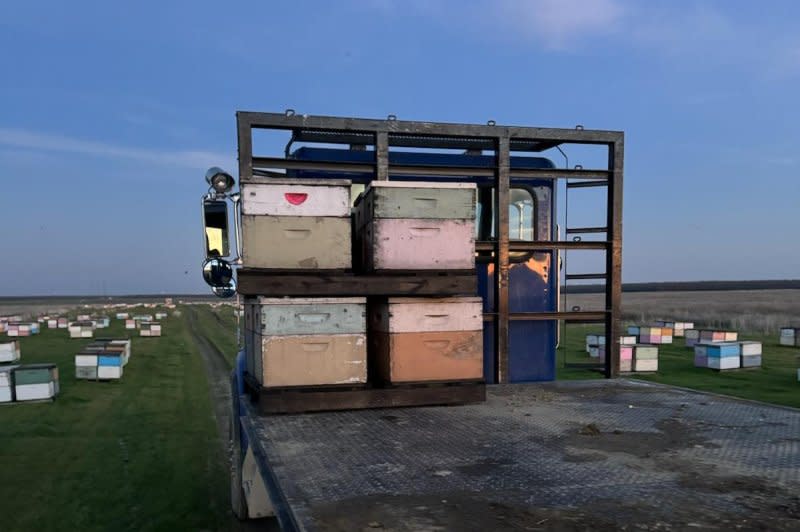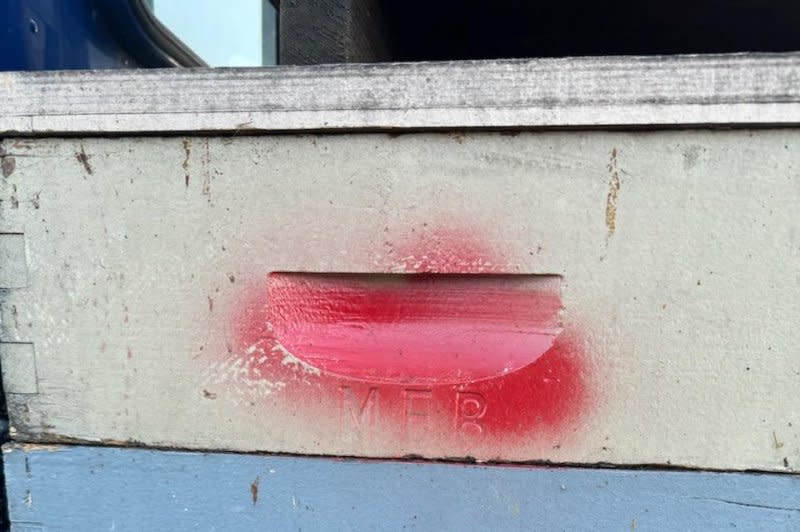Bee rustling season peaks as California almond trees blossom

Feb. 18 (UPI) -- Bee rustling isn't as well-known as cattle rustling, but it's very real and affects beekeepers and farms throughout the nation, especially in California.
Almond growers in California depend upon the services of beekeepers, who ship in hives from as far away as Florida to pollinate almond blossoms.
The state's annual almond tree blossom in February and March is the world's largest pollination event and requires billions of honey bees, according to the California Almond Board. The world's largest pollination event also is an opportunity for bee rustlers to remove valuable beehives from local farms.
California has about 840,000 native colonies of honeybees, but needs 2.4 million colonies to pollinate crops, the Almond Board says.
Bee rustlers stole about 2,300 beehives in California in 2023, which is a state record. Those thefts generally occurred in the state's fertile Central Valley region, where farmers contract with beekeepers to supply hives that contain millions of honey bees.

"So much is done over the phone," Tony Botti, Fresno County Sheriff's Department spokesman, told UPI. They take care of business over the phone and have no idea whether the beekeeper is providing legitimate hives or stolen ones or that bee rusting exists.
Most farmers either place an ad looking for beehives online or respond to ads posted by people saying they have beehives available, Botti said.
"The farmer checks and pays when he sees the beehives," Botti said. "The farmers don't know where they came from."
Butte County sheriff's Deputy Rowdy Freeman, who leads the California Rural Crime Prevention Task Force that investigates bee rustling, also compiles an annual Hive Theft Report for the California Almond Board that notes orchard owners pay up to $200 per hive to pollinate their almond blossoms.
Although 2024 isn't 2 months old, Freeman already has received at least 11 reports of stolen beehives that total 912 of the hives. Also stolen were two forklifts and a 22-foot trailer for hauling them.
Freeman's Hive Theft Report singles out one man who he says is a highly active bee rustler in the area.
The man allegedly was found with several stolen hives and likely has stolen several hives in recent years, Freeman said. His report said the suspect has at least one partner in his beehive theft operation in Fresno and Madera counties.
Freeman said they grind off the old brand, paint the stolen hives white and use a stencil to paint new brands on them.
Once the old hives are repainted and rebranded, Freeman said they transfer the stolen bees to the rebranded hives and use them to pollinate almond orchards.
Loosely placing beehives in almond orchards also makes it easy for bee rustlers to locate and steal them quickly under the cover of darkness or while it's raining and the bees are dormant, according to the Hive Theft Report.
The report says bee rustlers often use forklifts designed for rough terrain to collect and load stolen beehives onto the backs of flatbed trucks. It takes as little as 30 minutes to locate and remove beehives from an orchard.
One beekeeper victimized by the thefts is from South Dakota and has offered a $100,000 reward for the return of his hives.
The beekeeper trucked 416 beehives about 1,700 miles from South Dakota and placed them in an almond orchard in Fresno County in late January.
"The guy went out there a day later and found 96 missing," Botti said.
He said beekeepers try to make their beehives look unique so it's easier for them to spot which ones are theirs. They might apply particular paint schemes that create color combinations unique to their hives, and some etch their brands into the wooden boxes.
Others might design highly unique beehives or screens that make them one-of-a-kind so they can positively identify theirs if they are stolen or get mixed up with another beekeeper's hives.
In California's Fresno County, visiting and local beekeepers can protect their hives by registering them with the county sheriff's office. A deputy can issue a unique owner-applied number that is stamped onto the hives and recorded in the National Crime Information Center's directory.
The directory makes it easier for law enforcement to identify the rightful owners of the marked beehives and is a free service, Botti said.
Many times, the people who steal the hives are known to the owners of the stolen hives. Most people who steal beehives are experienced at beekeeping. Botti said many bee rustlers are trained by the same people whose hives they steal later.
Bee rustling has existed for many years, but has increased greatly since the 2007 onset of colony collapse disorder, which caused beekeepers to lose nearly one-third of the honey bee populations in their hives.
Reports of stolen hives increased after the 2007 die-off due to the increased demand for beehives, Botti said. A beehive is worth an about $350, so 100 stolen beehives would be worth $35,000.
Botti said bee rustlers are organized and often operate in teams of two or more people. The bee colonies usually die out after the pollination is done because the thieves don't bother caring for them.
Beekeepers get a dual income from leasing their beehives to farmers and after harvesting honey from the hives later in the year. The loss of honey adds to the financial loss that beekeepers suffer due because of the bee rustlers.
"These guys spend the entire off season getting hives together for the season, and then someone steals them," Botti said.
Honey bees pollinate more than 130 types of vegetables, fruits and nuts that produce about $15 billion in crops every year, according to the U.S. Department of Agriculture.
There is a greater demand for honey bees than nature provides, so beekeepers can earn good income by traveling around the country with their bees to enable pollination of crops throughout the country.
A beekeeper might start in Florida orchards in the fall, move to California orchards in February and finish in Michigan blueberry farms in the spring, according to the USDA.
When crops need pollination, bees are needed to make it happen, but bee rustlers are exploiting the process.

